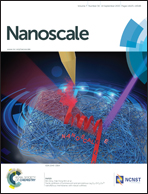Mesoporous silica particle-PLA–PANI hybrid scaffolds for cell-directed intracellular drug delivery and tissue vascularization†
Abstract
Instructive materials are expected to revolutionize stem cell based tissue engineering. As many stem cell cues have adverse effects on normal tissue homeostasis, there is a need to develop bioactive scaffolds which offer locally retained and cell-targeted drug delivery for intracellular release in targeted cell populations. Further, the scaffolds need to support vascularization to promote tissue growth and function. We have developed an electrospun PLA–PANI fiber scaffold, and incorporated mesoporous silica nanoparticles within the scaffold matrix to obtain cell-targeted and localized drug delivery. The isotropy of the scaffold can be tuned to find the optimal morphology for a given application and the scaffold is electroactive to support differentiation of contractile tissues. We demonstrate that there is no premature drug release from particles under physiological conditions over a period of one week and that the drug is released upon internalization of particles by cells within the scaffold. The scaffold is biocompatible, supports muscle stem cell differentiation and cell-seeded scaffolds are vascularized in vivo upon transplantation on the chorioallantoic membrane of chicken embryos. The scaffold is a step towards instructive biomaterials for local control of stem cell differentiation, and tissue formation supported by vascularization and without adverse effects on the homeostasis of adjacent tissues due to diffusion of biological cues.


 Please wait while we load your content...
Please wait while we load your content...